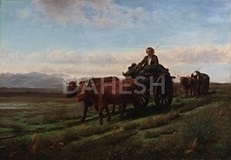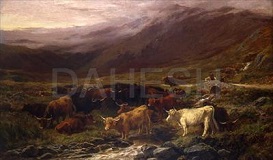Animals became increasingly popular as subjects in 19th-century French and British art. This passion for animals grew out of new theories in science, and natural history, as well as displays at the Jardin des Plantes in Paris (after the 1793 establishment of its menagerie) and the London Zoo (which opened in 1848). Fascination with the wild and irrational, and a growing urban middle class that romanticized the unspoiled countryside, also contributed to the allure of domesticated and wild animals. Paintings of sheep, horses, cows, fowl, and felines filled the walls of the Salons in Paris and the Royal Academy in London. Some artists, known as animaliers, took the subject as their specialty.
The British painter George Stubbs (1724–1806), famous for his precise anatomical rendition of horses, elevated representations of animals by adding the drama and heroism associated with history painting with works such as Horse Attacked by a Lion (1769, Tate Gallery). Stubbs’s exploration of emotional energy in his animal subjects inspired later French Romantic artists such as Eugène Delacroix (1798–1863) and Théodore Géricault (1791–1824), although history and narrative art remained the most substantial part of their work. It was their fellow artist, the well-known sculptor Antoine-Louis Barye (1796–1875), who almost exclusively modeled animals and elevated the genre to new heights. In addition to an energy and compositional tension found in the horse imagery of Gericault, Barye’s animals convey an anatomical clarity learned through observing the poses and movements of these animals, and attending dissections at the Jardin des Plantes. Rosa Bonheur (1822–99)—who, together with her siblings achieved worldwide popularity—also rooted her animal images in direct observation of nature, including at her private menagerie at her country estate. Constant Troyon (1810–1865), a painter associated with the plein-air Barbizon School, also achieved international success with animal paintings in a rapid and broadly brushed manner.
Across the channel, contemporaries James Ward (1769–1859) and Edwin Landseer (1802–73) dominated animal painting in the early 19th century. Ward’s vigorous compositions, such as this charming farmyard scene, appealed to the urban middle class nostalgia for a more nurturing rural environment. Landseer, a favorite of Queen Victoria (herself a lover of animals), often portrayed dogs, horses, and stags, among others, with humor and animation, but he also explored every aspect of “nature red in tooth and claw.” His legacy is revealed in works by such British animaliers as Richard Ansdell’s (1815–1885), seen here in Pet Fawn—a collaborative work with the great genre artist William Powell Frith (1819–1909). Other rural scenes with animals, such as Henry Garland’s (1854–90) landscape with cattle conformed to the taste for views of unspoiled nature.
The popularity of animal representation continued to exist side by side with the rise of modernism in art. Arthur Wardle (1864–1949) rendered his exotic subjects in their native homes in a traditional, naturalistic style. In France, Georges-Frédéric Rötig (1873–1961), who won the Prix Rosa Bonheur in 1913, continued to paint deer and wild boar roaming the French countryside, as well as lions and tigers prowling exotic landscapes, into the second half of the 20th century.











